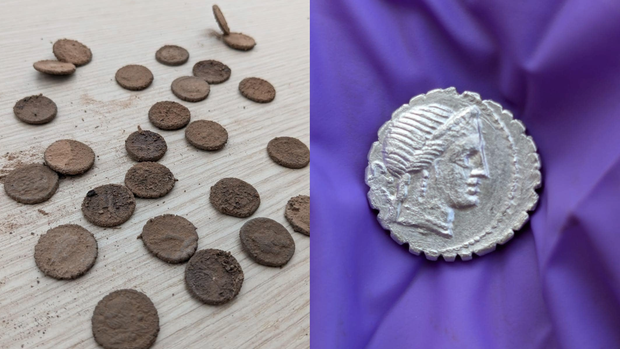Treasure trove of ancient silver coins found

A collection of ancient silver coins was unearthed recently on a small island in the Mediterranean Sea, officials said this week. The treasure trove dates back more than 2,000 years, with the origins estimated to be somewhere between 94 B.C. and 74 B.C.
Archaeologists found the coins “hidden in a hole in the wall” while performing restoration work on the Acropolis of Santa Teresa and San Marco, a historic landmark on the island of Pantelleria off the southern coast of Italy, between Sicily and Tunisia, the regional heritage office for the island announced on Monday.
There were 27 of them, each characterized as a denarius — the main silver coin used in ancient Rome for several centuries after its introduction around 200 B.C.
Archaeological Park of Selinunte, Cave di Cusa and Pantelleria
The team, led by Thomas Schäfer from the University of Tübingen in Germany, initially spotted some of the coins by chance in soil that had loosened after a period rain, officials said. They then dug beneath a rock to uncover the rest of the haul. The coins were cleaned and restored before the announcement was posted to the Facebook page for the archaeological park encompassing Pantelleria and two other sites on Sicily’s mainland, Cave di Cusa and Selinunte.
The coins were minted during the Roman Republic, which existed for nearly 500 years until the the founding of the Roman Empire in 27 B.C.
This latest find came after another trove of the same variety of silver Roman coins, dating back to roughly the same time period, was discovered at the same site on Pantelleria in 2010. Officials said that initial haul included 107 coins. A few years before that, excavations near those sites led to the discovery of three marble sculptures depicting the heads of former Roman emperors Julius Caesar and Titus Flavius Vespasian, as well as Agrippina, an empress and prominent female figure in ancient Rome. The sculptures have been displayed at the Salinas Museum in Palermo as well as the British Museum in London.
Officials said the newest discovery on Pantelleria is valuable to archaeologists and historians in the region as it contributes to their understanding of the Roman Republic, how it was structured and what politics and commerce might have been like in the Mediterranean at that time.
Schäfer suggested that the treasure could have potentially ended up in the spot where his team found it after being hidden intentionally during an invasion of the island by pirates, which happened often in ancient times. The archaeologist said it was possible the treasure was buried back then and never recovered because so much of the acropolis remained untouched for centuries.










